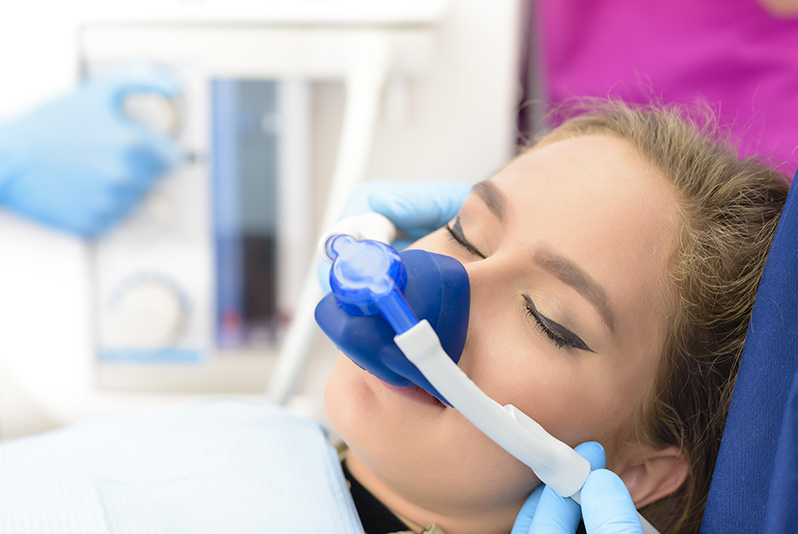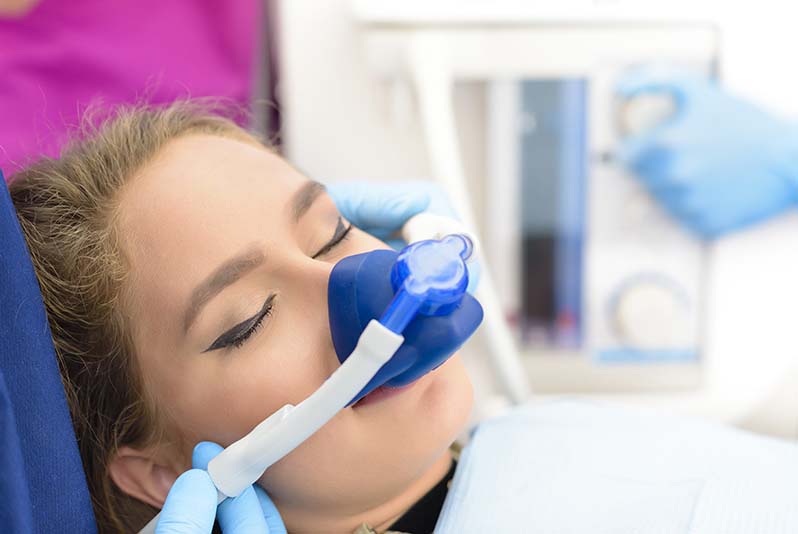- What is Sedation Dentistry?
- Who is a Candidate for Sedation Dentistry?
- How Safe is Sedation Dentistry?
- What are the Benefits of Sedation Dentistry?
- How Does Nitrous Oxide Work in Dentistry?
- How to Get Over My Fear and Anxiety of Going to the Dentist
- How Much Does it Cost for Sedation Dentistry?
- What are the Types of Sedation Dentistry?
- Can You Be Put to Sleep for Dental Implants?
- Other Dental Procedures That Can Leverage Sedation Dentistry
Whether you need to have a cavity filled or require a more extensive root canal procedure, sedation dentistry is a form of dentistry that you’ll likely encounter at some point in your life, which is why it’s important to be aware of all that this dentistry entails and what it means for you. Here at Southland Dental Care in Los Angeles, our dentists use sedation dentistry regularly to make sure that you and all of our other patients are always comfortable.
What is Sedation Dentistry?
Sedation dentistry is a form of dentistry that refers to the administration of various sedative drugs. These drugs are designed to aid the dental procedure by reducing or eliminating the amount of pain that an individual experiences throughout the treatment, which should invariably help to reduce the amount of anxiety that the patient goes through. There are a variety of different types of sedation that can be used during a dental treatment, which extend from laughing gas to general anesthesia that causes a loss of consciousness while the procedure is ongoing.
When you’re thinking about obtaining a dental procedure but are too afraid of the pain incurred by the treatment, sedation dentistry will help put you at ease so that you can go into the procedure with confidence. The administration of anesthesia takes only a minute or so and will prepare you for the treatment that’s about to take place. Whether you have a general fear of pain or don’t enjoy being close to needles, the forms of anesthesia used within sedation dentistry will help you conquer these fears for current and future treatments.

Who is a Candidate for Sedation Dentistry?
Practically anyone is a candidate for sedation dentistry in Los Angeles. Since there are varying degrees of anesthesia that you can be provided with, your dentist will make sure that you receive the type that best matches your needs. For a couple of the more comprehensive forms of sedation such as general anesthesia and IV sedation, there are several factors that will be taken into consideration to determine whether or not these anesthesia types are right for you. Your general medical history will be looked at, which includes your physical and mental health.
There are also a variety of conditions and diseases that will need to be cleared by a physician in order for the patient to receive sedation. These conditions include diabetes, cardiac disease, respiratory disease, and hypertension. A physical assessment will typically be administered before the procedure is scheduled to make sure that you’re a good candidate. If you are considered to be a good candidate for sedation dentistry, it can be applied for nearly all dental procedures.
How Safe is Sedation Dentistry?
Sedation dentistry is an exceedingly safe practice as long as the patient’s vitals are monitored constantly throughout the procedure, which is only important if you select a type of sedation that puts you to sleep during the treatment. People who suffer from obstructive sleep apnea or are overweight will need to speak to their doctor about which type of sedation is right for them. If you suffer from one of these conditions, you’re more likely to experience various complications that result from the anesthesia. Since there are a variety of different medications used in sedation dentistry, it’s important to understand that everyone will react differently to sedation dentistry. However, the administration of anesthesia is usually very safe.
While all forms of sedation dentistry are safe, some are safer than others. Laughing gas is only designed to help you relax, which means that there are hardly any risks associated with the sedation technique. On the other hand, general anesthesia places you in a very deep sleep. While the effects of this anesthesia will wear off over a certain period of time, it’s possible that there will be complications that the dentist will need to handle. When placed in general anesthesia, your blood pressure and heart rate will be monitored at all times to make sure that you’re responding well to the anesthesia.
What are the Benefits of Sedation Dentistry?
There are several substantial benefits that you will receive when being provided with sedation dentistry. If you have a general fear of visiting the dentist or are particularly anxious about a more serious dental procedure that you’re undergoing, anesthesia is designed to put your mind at ease and help you relax throughout the procedure. Aside from laughing gas, all other forms of sedation will also reduce or completely eliminate the amount of pain that you experience during the treatment. You will be provided with a beautiful smile without feeling the pain that would otherwise occur with such a treatment.
Sedation dentistry also helps to shorten the amount of time that you will need to spend at a dental office. Dentists are able to cover much more ground during a dental procedure when the patient has received some form of anesthesia. With the patient calm and relaxed, the dentist is able to progress through the treatment quicker without needing to constantly make sure that the patient has adjusted to a new movement or technique that’s used during the procedure.
How Does Nitrous Oxide Work in Dentistry?
Nitrous oxide is typically referred to as laughing gas and is the more common type of sedation that’s used with this form of dentistry. Nitrous oxide is unique in that you breathe it in via a mask that’s placed directly over your nose. Your dentist will determine exactly how much of this gas you will receive. The gas itself wears off quickly, which means that this type of sedation is typically reserved for situations where the procedure is going to be completed in a short period of time.
Although you won’t be put to sleep with nitrous oxide, the gas will allow you to relax and be more at peace while the treatment is ongoing. In many cases, injections of local anesthesia are combined with nitrous oxide to provide patients with a comfortable and pain-free procedure. Since the gas wears off quickly, the main benefit of this type of anesthesia is that you will likely be able to drive home without assistance once the treatment has been completed, which can’t be said about any of the other anesthesia options that are available to you.
How to Get Over My Fear and Anxiety of Going to the Dentist
While sedation dentistry is a wonderful way to mitigate the fear and anxiety that you experience when going to the dentist, you might also want to consider taking the necessary steps towards getting over that fear for good. Many people have some type of fear that relates to going to the dentist, which can include anything from a fear of the drill used in numerous procedures to a fear of needles. The first thing to do is to find a dentist who understands your fear and is willing to accommodate it. If the dentist you meet with isn’t empathetic about your fears, it’s likely that they will only serve to amplify these fears.
Make sure that you identify your fear, which is the only way that you can overcome it. Once you’ve chosen a dentist who is willing to listen to your concerns and cares about your experience, you should focus on getting ready for the appointment itself. Try to take someone with you to the treatment who can keep you calm. You should also ask your dentist about how painful the treatment should be. Knowing what to expect beforehand may reduce some of your fears. If necessary, ask for some type of sedation. You should also try to practice a few breathing and meditative techniques while waiting for the date of the appointment. If the fears subsist, don’t be afraid to obtain professional help. Once you deal with what’s causing your fear, you’ll be able to go to your next dentist appointment without a care in the world.
How Much Does it Cost for Sedation Dentistry?
When you’re considering whether or not you’ll obtain sedation dentistry, you’re likely wondering how much this treatment will cost. General costs for sedation depend on the type of sedation that you receive. Nitrous oxide usually only costs anywhere from $25-50. On the other hand, intravenous sedation or general anesthesia can cost hundreds of dollars for a single injection.
Here at Southland Dental Care, our sedation dentistry techniques are completely free for all major dental treatments, which means that you don’t need to worry about the costs associated with the treatment. We understand that major dental procedures invariably cause anxiety, which is why we want to do everything we can to minimize this stress. Making sedation dentistry free with these major treatments means that you will only need to consider the costs of the actual procedure that you’re receiving.
What are the Types of Sedation Dentistry?
There are four basic types of sedation dentistry, which include nitrous oxide, enteral sedation, IV sedation, or general anesthesia. These types of sedation are ordered from simple to complex, which means that nitrous oxide is mild, while general sedation is the more serious of the four options. As touched upon previously, nitrous oxide is designed solely to put you at ease and help you relax while the treatment is progressing. This sedation will wear off relatively quickly compared to your other options, which is due mainly to it being breathed in. Enteral sedation is taken orally and is available as either a liquid or pill. It is typically combined with nitrous oxide for a more effective solution. While this sedation method won’t put you to sleep, it should calm your nerves and reduce the amount of pain that you experience.
Intravenous sedation makes use of a solution that’s placed directly into one of your veins, which means that the effects of the sedation will occur very quickly. Although you stay awake with IV sedation, you won’t feel any pain. There are also times when you will want to consider general anesthesia, which will put you to sleep for the duration of the treatment. The anesthesia will eventually wear off. Each type of anesthesia has its benefits. Ask your dentist in Los Angeles about which sedation is right for you.
Can You Be Put to Sleep for Dental Implants?
Sedation dentistry is almost always used for the placement of dental implants. This is a type of surgery that replaces the roots of your teeth with metallic posts that artificial teeth can be connected to. The primary benefit of obtaining dental implants over other solutions is that these implants heavily support new tooth. While dental implants can provide you with a wide range of advantages, this procedure would be a decidedly painful one without the usage of anesthesia.
In most cases, you will be provided with nitrous oxide in combination with one of the other three types of sedation. Nitrous oxide alone isn’t enough to dull the pain. Although enteral sedation is the safest sedation type to use for dental implant surgery, intravenous sedation and general anesthesia are the more effective options at your disposal. Since the pain from dental implants can be high, you should heavily consider obtaining IV sedation at the very least. General anesthesia can also be beneficial but is something that you will want to speak with your dentist about beforehand. If you are looking for a Los Angeles dental implants specialist, contact us today for your dental consultation.
Other Dental Procedures That Can Leverage Sedation Dentistry
Since sedation dentistry includes a range of different types of anesthesia, this form of dentistry is leveraged by nearly all types of dental procedures. Although anesthesia doesn’t need to be used with all dental procedures, it’s common with cavity fillings, root canals, gum surgery, the placement of crowns, and tooth removal treatments. The most common form of sedation to be used with cavity fillings is IV sedation. Since this type of sedation can be injected locally at the site of the cavity, only a small area of your body will need to be numbed.
For more serious dental surgeries like root canals and the placement of a crown, it’s possible that general anesthesia will be necessary. If the pain is going to be too high, general anesthesia will be recommended. This is often the case with dental surgeries. While the placement of a crown doesn’t cause much pain in and around the tooth, the tooth will need to be reshaped before the crown is placed, which is where the pain primarily comes from. Other dental procedures that use sedation dentistry to great effect include common procedures like wisdom tooth extraction and dental implant surgery.
Related Articles:
- The Definitive Dental Implant Guide for Patients in Los Angeles
- How to Afford the Cost of Dental Implant Procedures
- Top Dentist Near Me in Los Angeles | Find Trusted Dental Care at Southland Dental Care
- Cosmetic Dentistry
- All-on-X Dental Implants Cost
- Cosmetic Dentistry Los Angeles
- Am I a Candidate for Dental Implants? A Comprehensive Guide to Causes, Symptoms, and…
- A Complete Guide to Tooth Extraction in Los Angeles, CA
- Dental Implants Surgery in Los Angeles
- What is a smile makeover
- What can you do for missing teeth in 2023?
- Dental Implant Complications and Failure
- Free Dental Implants Consultation
- Sedation Dentistry Guide - Los Angeles CA
- Factors to Consider before Choosing a Dental Implant Specialist
Request a Free Consultation
Tel: 818.788.8787
Related Posts
Related Articles:
- The Definitive Dental Implant Guide for Patients in Los Angeles
- How to Afford the Cost of Dental Implant Procedures
- Top Dentist Near Me in Los Angeles | Find Trusted Dental Care at Southland Dental Care
- Cosmetic Dentistry
- All-on-X Dental Implants Cost
- Cosmetic Dentistry Los Angeles
- Am I a Candidate for Dental Implants? A Comprehensive Guide to Causes, Symptoms, and…
- A Complete Guide to Tooth Extraction in Los Angeles, CA
- Dental Implants Surgery in Los Angeles
- What is a smile makeover
- What can you do for missing teeth in 2023?
- Dental Implant Complications and Failure
- Free Dental Implants Consultation
- Sedation Dentistry Guide - Los Angeles CA
- Factors to Consider before Choosing a Dental Implant Specialist





